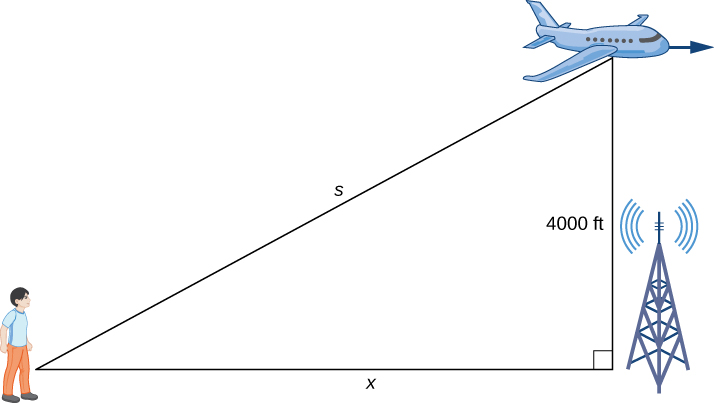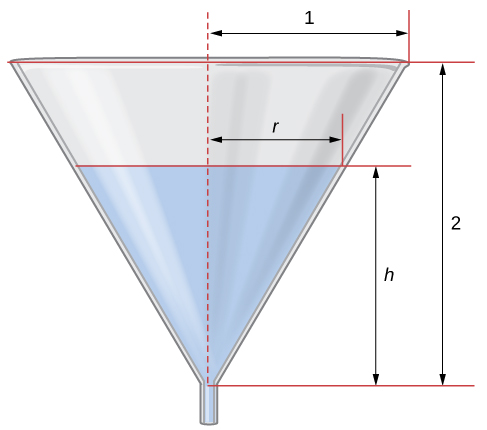Learning Outcomes
- Express changing quantities in terms of derivatives.
- Find relationships among the derivatives in a given problem.
- Use the chain rule to find the rate of change of one quantity that depends on the rate of change of other quantities.
Setting up Related-Rates Problems
In many real-world applications, related quantities are changing with respect to time. For example, if we consider the balloon example again, we can say that the rate of change in the volume, [latex]V[/latex], is related to the rate of change in the radius, [latex]r[/latex]. In this case, we say that [latex]\frac{dV}{dt}[/latex] and [latex]\frac{dr}{dt}[/latex] are related rates because [latex]V[/latex] is related to [latex]r[/latex]. Here we study several examples of related quantities that are changing with respect to time and we look at how to calculate one rate of change given another rate of change.
Example: Inflating a Balloon
A spherical balloon is being filled with air at the constant rate of [latex]2 \, \frac{\text{cm}^3}{\text{sec}}[/latex] (Figure 1). How fast is the radius increasing when the radius is [latex]3\, \text{cm}[/latex]?

Figure 1. As the balloon is being filled with air, both the radius and the volume are increasing with respect to time.
Watch the following video to see the worked solution to Example: Inflating a Balloon.
Try It
What is the instantaneous rate of change of the radius when [latex]r=6 \, \text{cm}[/latex]?
Try It
Before looking at other examples, let’s outline the problem-solving strategy we will be using to solve related-rates problems.
Problem-Solving Strategy: Solving a Related-Rates Problem
- Assign symbols to all variables involved in the problem. Draw a figure if applicable.
- State, in terms of the variables, the information that is given and the rate to be determined.
- Find an equation relating the variables introduced in step 1.
- Using the chain rule, differentiate both sides of the equation found in step 3 with respect to the independent variable. This new equation will relate the derivatives.
- Substitute all known values into the equation from step 4, then solve for the unknown rate of change.
We are able to solve related-rates problems using a similar approach to implicit differentiation. In the example below, we are required to take derivatives of different variables with respect to time [latex]{t}[/latex], ie. [latex]{s}[/latex] and [latex]{x}[/latex]. When this happens, we can attach a [latex]\frac{ds}{dt}[/latex] or a [latex]\frac{dx}{dt}[/latex] to the derivative, just as we did in implicit differentiation.
Note that when solving a related-rates problem, it is crucial not to substitute known values too soon. For example, if the value for a changing quantity is substituted into an equation before both sides of the equation are differentiated, then that quantity will behave as a constant and its derivative will not appear in the new equation found in step 4. We examine this potential error in the following example.
Examples of the Process
Let’s now implement the strategy just described to solve several related-rates problems. The first example involves a plane flying overhead. The relationship we are studying is between the speed of the plane and the rate at which the distance between the plane and a person on the ground is changing.
Example: An Airplane Flying at a Constant Elevation
An airplane is flying overhead at a constant elevation of [latex]4000[/latex] ft. A man is viewing the plane from a position [latex]3000[/latex] ft from the base of a radio tower. The airplane is flying horizontally away from the man. If the plane is flying at the rate of [latex]600[/latex] ft/sec, at what rate is the distance between the man and the plane increasing when the plane passes over the radio tower?
Watch the following video to see the worked solution to Example: An Airplane Flying at a Constant Elevation.
Try It
What is the speed of the plane if the distance between the person and the plane is increasing at the rate of [latex]300[/latex] ft/sec?
Try It
What rate of change is necessary for the elevation angle of the camera if the camera is placed on the ground at a distance of [latex]4000[/latex] ft from the launch pad and the velocity of the rocket is [latex]500[/latex] ft/sec when the rocket is [latex]2000[/latex] ft off the ground?
Try It
In the next example, we consider water draining from a cone-shaped funnel. We compare the rate at which the level of water in the cone is decreasing with the rate at which the volume of water is decreasing.
Example: Water Draining from a Funnel
Water is draining from the bottom of a cone-shaped funnel at the rate of [latex]0.03 \, \text{ft}^3 /\text{sec}[/latex]. The height of the funnel is [latex]2[/latex] ft and the radius at the top of the funnel is [latex]1[/latex] ft. At what rate is the height of the water in the funnel changing when the height of the water is [latex]\frac{1}{2}[/latex] ft?
Try It
At what rate is the height of the water changing when the height of the water is [latex]\frac{1}{4}[/latex] ft?
Try It
Candela Citations
- 4.1 Related Rates. Authored by: Ryan Melton. License: CC BY: Attribution
- Calculus Volume 1. Authored by: Gilbert Strang, Edwin (Jed) Herman. Provided by: OpenStax. Located at: https://openstax.org/details/books/calculus-volume-1. License: CC BY-NC-SA: Attribution-NonCommercial-ShareAlike. License Terms: Access for free at https://openstax.org/books/calculus-volume-1/pages/1-introduction


